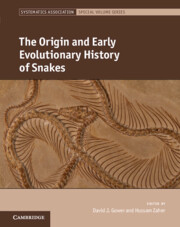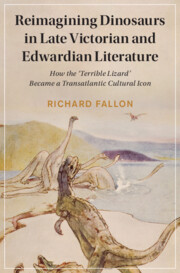Refine search
Actions for selected content:
41 results
The early actinopterygian genus Rhadinichthys redefined, the type species ornatissimus redescribed, and the species bearsdeni introduced
- Part of
-
- Journal:
- Earth and Environmental Science Transactions of The Royal Society of Edinburgh / Volume 115 / Issue 3-4 / October 2024
- Published online by Cambridge University Press:
- 20 October 2025, pp. 113-129
- Print publication:
- October 2024
-
- Article
-
- You have access
- Open access
- HTML
- Export citation
New light on the braincases of Ventastega curonica and Acanthostega gunnari
- Part of
-
- Journal:
- Earth and Environmental Science Transactions of The Royal Society of Edinburgh / Volume 115 / Issue 3-4 / October 2024
- Published online by Cambridge University Press:
- 20 October 2025, pp. 154-163
- Print publication:
- October 2024
-
- Article
-
- You have access
- Open access
- HTML
- Export citation
clocks replaced with : ; . [Deschooling Time in the Small Isles]
-
- Journal:
- Cambridge Prisms: Extinction / Volume 2 / 2024
- Published online by Cambridge University Press:
- 03 September 2024, e11
-
- Article
-
- You have access
- Open access
- HTML
- Export citation
Morphological variation in the rangeomorph organism Fractofusus misrai from the Ediacaran of Newfoundland, Canada
-
- Journal:
- Geological Magazine / Volume 160 / Issue 1 / January 2023
- Published online by Cambridge University Press:
- 18 August 2022, pp. 146-166
-
- Article
-
- You have access
- Open access
- HTML
- Export citation
14 - A Glimpse into the Evolution of the Ophidian Brain
- from Part IV - Neurobiological Perspectives
-
-
- Book:
- The Origin and Early Evolutionary History of Snakes
- Published online:
- 30 July 2022
- Print publication:
- 11 August 2022, pp 294-315
-
- Chapter
- Export citation
4 - The Diversity and Distribution of Palaeogene Snakes
- from Part I - The Squamate and Snake Fossil Record
-
-
- Book:
- The Origin and Early Evolutionary History of Snakes
- Published online:
- 30 July 2022
- Print publication:
- 11 August 2022, pp 55-84
-
- Chapter
- Export citation
1 - Introduction
-
-
- Book:
- The Origin and Early Evolutionary History of Snakes
- Published online:
- 30 July 2022
- Print publication:
- 11 August 2022, pp 1-4
-
- Chapter
- Export citation
3 - The First 80 Million Years of Snake Evolution
- from Part I - The Squamate and Snake Fossil Record
-
-
- Book:
- The Origin and Early Evolutionary History of Snakes
- Published online:
- 30 July 2022
- Print publication:
- 11 August 2022, pp 26-54
-
- Chapter
- Export citation
13 - Using Adaptive Traits in the Ear to Estimate Ecology of Early Snakes
- from Part IV - Neurobiological Perspectives
-
-
- Book:
- The Origin and Early Evolutionary History of Snakes
- Published online:
- 30 July 2022
- Print publication:
- 11 August 2022, pp 271-293
-
- Chapter
- Export citation
2 - The Origin and Early Diversification of Squamates
- from Part I - The Squamate and Snake Fossil Record
-
-
- Book:
- The Origin and Early Evolutionary History of Snakes
- Published online:
- 30 July 2022
- Print publication:
- 11 August 2022, pp 7-25
-
- Chapter
- Export citation

The Origin and Early Evolutionary History of Snakes
-
- Published online:
- 30 July 2022
- Print publication:
- 11 August 2022
Special issue, ‘The Ediacaran System and the Ediacaran–Cambrian Transition’: Preface
-
- Journal:
- Geological Magazine / Volume 159 / Issue 7 / July 2022
- Published online by Cambridge University Press:
- 14 July 2022, pp. 997-998
-
- Article
-
- You have access
- HTML
- Export citation
A terrestrial record of climate variation during MIS 11 through multiproxy palaeotemperature reconstructions from Hoxne, UK
-
- Journal:
- Quaternary Research / Volume 111 / January 2023
- Published online by Cambridge University Press:
- 11 July 2022, pp. 21-52
-
- Article
- Export citation
Conclusion - Dinosaurs Rewritten
-
- Book:
- Reimagining Dinosaurs in Late Victorian and Edwardian Literature
- Published online:
- 28 October 2021
- Print publication:
- 04 November 2021, pp 174-184
-
- Chapter
- Export citation
Introduction - Dinosaurs in Transition
-
- Book:
- Reimagining Dinosaurs in Late Victorian and Edwardian Literature
- Published online:
- 28 October 2021
- Print publication:
- 04 November 2021, pp 1-28
-
- Chapter
- Export citation
Chapter 4 - Rediscovering Lost Worlds: Arthur Conan Doyle and the Modern Romance of Palaeontology
-
- Book:
- Reimagining Dinosaurs in Late Victorian and Edwardian Literature
- Published online:
- 28 October 2021
- Print publication:
- 04 November 2021, pp 136-173
-
- Chapter
- Export citation
Chapter 2 - Reinventing Wonderland: Jabberwocks, Grotesque Monsters, and Dinosaurian Maladaptation
-
- Book:
- Reimagining Dinosaurs in Late Victorian and Edwardian Literature
- Published online:
- 28 October 2021
- Print publication:
- 04 November 2021, pp 63-98
-
- Chapter
- Export citation
Chapter 1 - Reclaiming Authority: Henry Neville Hutchinson, Popular Science, and the Construction of the Dinosaur
-
- Book:
- Reimagining Dinosaurs in Late Victorian and Edwardian Literature
- Published online:
- 28 October 2021
- Print publication:
- 04 November 2021, pp 29-62
-
- Chapter
-
- You have access
- HTML
- Export citation

Reimagining Dinosaurs in Late Victorian and Edwardian Literature
- How the ‘Terrible Lizard' Became a Transatlantic Cultural Icon
-
- Published online:
- 28 October 2021
- Print publication:
- 04 November 2021
An enigmatic lower jaw from the Lower Muschelkalk (Anisian, Middle Triassic) of Winterswijk provides insights into dental configuration, tooth replacement and histology
-
- Journal:
- Netherlands Journal of Geosciences / Volume 100 / 2021
- Published online by Cambridge University Press:
- 18 October 2021, e17
-
- Article
-
- You have access
- Open access
- HTML
- Export citation
